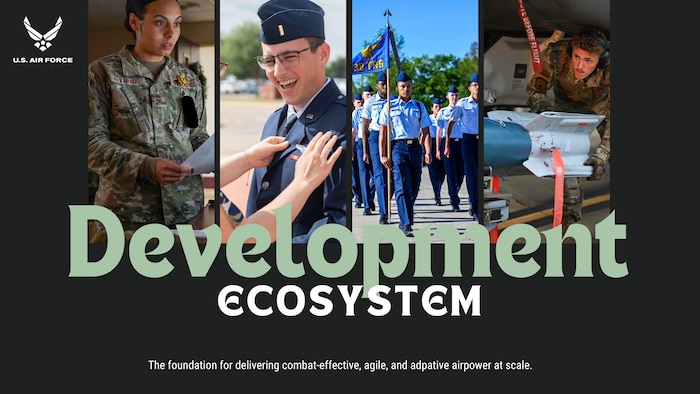Any future fight against a near-peer adversary will demand the U.S. Air Force deliver combat-effective, agile and adaptive airpower at scale. This will require Airmen who can make quality decisions at the speed necessary for competition and combat timelines, and developing future leaders who can do the same.
In line with Department of the Air Force's efforts to reoptimize for Great Power Competition, leaders at Air Education and Training Command are following through on upgrading the service's development ecosystem with a goal of providing digital-age training and education in alignment with the evolving needs of the warfighter.
"Reimagining our current approach to training and educating Airmen for GPC holds the potential for transformative change across multiple dimensions," said Dr. Wendy Walsh, AETC chief learning officer. "The advantages of this approach include the focused ability to rapidly recruit, train and educate Airmen with the competencies required to meet the evolving demands of joint force commanders in the GPC landscape in line with the Air Force Future Operating Concept."
So, what exactly is the development ecosystem?
"If you're looking at the set of tools that an Airman will interact with over the course of their Air Force careers, the development ecosystem spans the entirety of training and education experiences they encounter from accession to retirement," Walsh said. "This includes the instruction they receive at basic military training, at technical training or at undergraduate flying training, and onward to their experience during professional military education courses and in their units in the operational commands."
According to Walsh, the development ecosystem does not stop after initial basic military, technical training or undergraduate flying training; rather it is a competency-based, human-centered learning continuum that is informed and driven by a myriad of learning data and records, orientating the force to measurable, mission-focused outcomes.
"Once Airmen go out to their operational wings, the question is how will we continue to develop them in both their foundational and occupational competencies so they can do their job better, making them more effective Airmen, teammates and eventually leaders," Walsh said. "Building competency integration and learning design establishes a learner-centric model anchored to mission-command and the strategic context of GPC and is divorced from the industrial age 'pipelines' or 'training conveyor belts' of the past."
Rapidly codifying competencies required for GPC has been a top priority in the command.
"Currently, over half of the Air Force's career fields are implementing competency-based training plans with a goal to have all career fields complete by summer of 2025," said Col. Sandra Coble who leads headquarters AETC's competencies division. "We're moving fast to accomplish this training transformation knowing exactly how important this is to Air Force readiness."
Competencies also provide a framework by which the Force Development enterprise can organize, categorize and pursue data sources necessary for data-driven insights to help units assess overall readiness for specific missions.
"Striking a balance between talent management and operational needs is a complex challenge, but the integration of talent management processes with force development offers the opportunity for more efficient resource allocation," said Col. Jason Turner, AETC's deputy director for force development. "This alignment ensures that AETC produces Airmen with the right competencies at the right time, for the right place, enhancing overall readiness and effectiveness."
A major step in aligning talent management and operational needs is underway with the on-going development of the DAF Learning Record.
"Think of the DAFLR as a dynamic transcript of your learning and competencies, representing an individual digital portfolio consolidating learning-specific information for total force Airmen and Guardians from 32 authoritative data sources," Turner said. "The intent is to provide a one-stop, near-real-time, validated record of an individual's education, training and experience across a learner's career."
DAFLR includes 32 authoritative data sources, such as MyLearning, MyVector, the Military Personnel Data System, the Defense Civilian Personnel Data System, the Education and Training Management System and more.
"Commanders, their staffs and every Airman and Guardian will have access to near-real-time learning information guiding force-development decisions, including decisions that will impact operational readiness in support of agile combat employment," Turner said. "DAFLR will enhance lethality through knowledge of what military and civilian personnel know and can do, assisting commanders in developing the right Airmen and Guardians at the right time for the right mission."
The two-way partnership between AETC and operational commands, will be a critical factor in overall force development.
"[AETC] is providing a service that spreads across the entire DAF," Turner said. "It is the matching between the development that a person receives while they are in AETC with where the mission needs are when they are sent out to their operational units. This requires a feedback loop where the operational commands can request training, and then receive that training and not have to wait to send that person back to a formal schoolhouse. Being able to upskill in real time to meet the needs of the warfighter at the point of need."
To illustrate the point of what a successful future development ecosystem looks like, Turner gave the example of a team at Andersen Air Force Base, Guam, developing a new training method demonstrating how to refuel a B-52 Stratofortress in an austere environment. To rapidly share that information across the enterprise, that new training module can rapidly be taken back to the aircraft's home station at Barksdale AFB, Louisiana, and be implemented there in real-time to match operational need during a conflict.
"Our current ecosystem has pockets of excellence everywhere, with great leaders doing innovative things," Walsh said. "Our future success means getting our learning ecosystem to effectively connect across institutional and operational commands, to identify and train with a competency-based approach, to share best practices and collaborate on how to incorporate digital age technology into development, and to adapt learning opportunities when and where needed for mission readiness."







